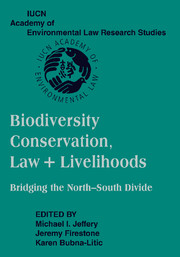 Biodiversity Conservation, Law and Livelihoods: Bridging the North-South Divide
Biodiversity Conservation, Law and Livelihoods: Bridging the North-South Divide Published online by Cambridge University Press: 31 July 2009
BACKGROUND
The major flooding of the Songhua River and Nenjiang River in North-east China in 1998 was the first time that People's Republic of China (PRC) had to face a chaotic disaster that could be attributed solely to poor management of the water, land and forest resources. By 2000 a cycle of frequent and severe dust storms was occurring each spring in Northern China, with more than 20 such episodes in 2002.
These disastrous meteorological phenomena happened in a brief period, and heightened social and political concerns about ecological conservation including natural forest management in northeastern regions. One of the most significant policy responses was that the State Council issued the National Compendium of the Conservation of Ecological Environment (NCCEE) in 2000. The NCCEE determined that natural disasters were driven more by human action than by natural forces such as unusual weather. The irrational management and abuse of land, water, and other natural resources were the key human factors to cause adverse environmental effects. The NCCEE proposed a new instrument – ecological function zoning – to address sustainable land use, natural resource utilization, and industrial processing. The objective of ecological function zoning is to provide a scientific baseline to economic growth and safeguard sustainability of the environment.
The authority over ecological function zoning was delegated to two key ministerial-level agencies, the Western Development Leading Group Office (WDLGO) of the State Council and the State Environmental Protection Agency (SEPA).
To save this book to your Kindle, first ensure [email protected] is added to your Approved Personal Document E-mail List under your Personal Document Settings on the Manage Your Content and Devices page of your Amazon account. Then enter the ‘name’ part of your Kindle email address below. Find out more about saving to your Kindle.
Note you can select to save to either the @free.kindle.com or @kindle.com variations. ‘@free.kindle.com’ emails are free but can only be saved to your device when it is connected to wi-fi. ‘@kindle.com’ emails can be delivered even when you are not connected to wi-fi, but note that service fees apply.
Find out more about the Kindle Personal Document Service.
To save content items to your account, please confirm that you agree to abide by our usage policies. If this is the first time you use this feature, you will be asked to authorise Cambridge Core to connect with your account. Find out more about saving content to Dropbox.
To save content items to your account, please confirm that you agree to abide by our usage policies. If this is the first time you use this feature, you will be asked to authorise Cambridge Core to connect with your account. Find out more about saving content to Google Drive.